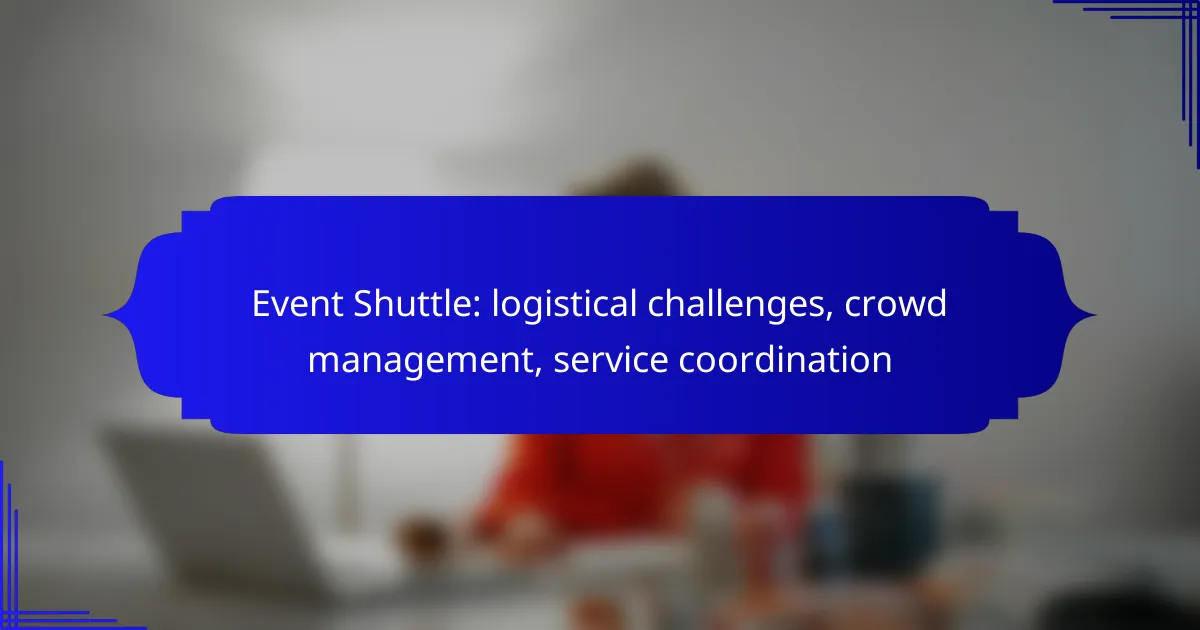Event shuttles in London encounter various logistical challenges that can hinder their performance, such as traffic congestion and the need for coordination with local authorities. To ensure a smooth experience for attendees, effective crowd management and service coordination are essential, involving strategic planning and the use of technology for real-time communication. By implementing centralized booking systems and fostering partnerships with local transport services, shuttle operations can be streamlined, reducing wait times and enhancing passenger satisfaction.
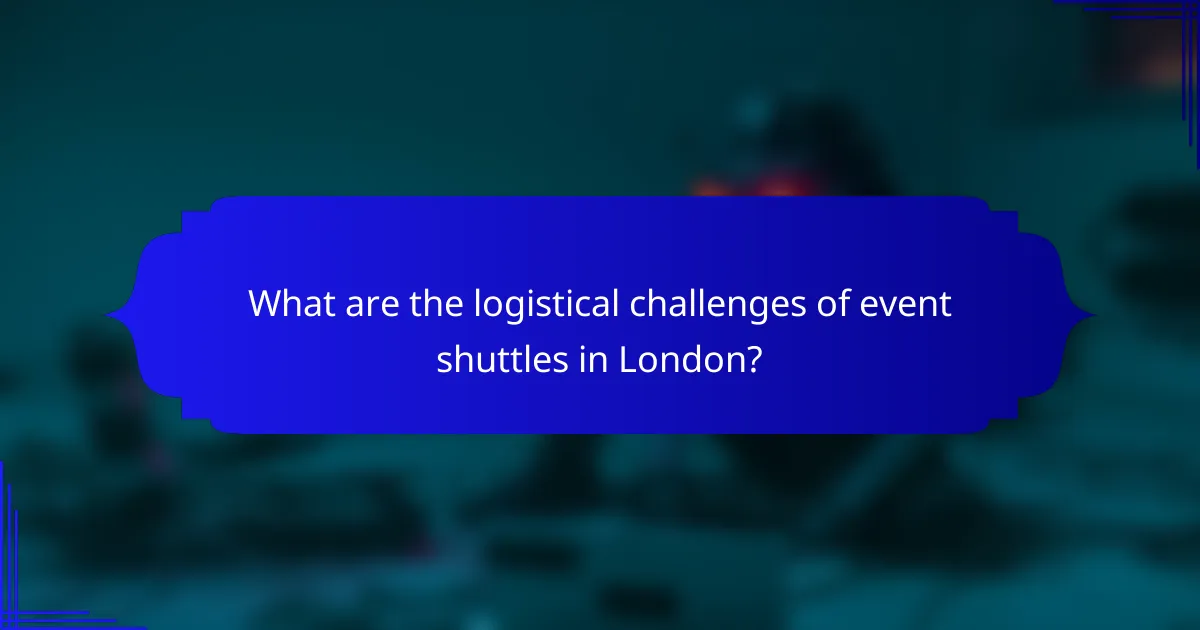
What are the logistical challenges of event shuttles in London?
Event shuttles in London face several logistical challenges that can impact their efficiency and effectiveness. Key issues include traffic congestion, insufficient parking, last-minute changes, and the need for coordination with local authorities.
Traffic congestion
Traffic congestion is a significant challenge for event shuttles in London, particularly during peak hours or major events. High volumes of vehicles can lead to delays, making it essential to plan routes that avoid the busiest areas whenever possible.
To mitigate congestion, shuttle services should consider using real-time traffic data to adjust routes dynamically. This approach can help minimize delays and improve the overall experience for passengers.
Insufficient parking
Finding adequate parking for shuttles can be problematic in London, especially near event venues. Limited space often results in long walks for passengers, which can detract from their experience.
Event organizers should work closely with venues to secure designated parking areas for shuttles. Planning for overflow options can also help accommodate larger crowds and prevent bottlenecks.
Last-minute changes
Last-minute changes, such as schedule adjustments or venue alterations, can disrupt shuttle operations. These changes may arise from unforeseen circumstances like weather conditions or logistical issues.
To handle last-minute changes effectively, shuttle services should maintain flexible schedules and have contingency plans in place. Clear communication with passengers about any updates is crucial to ensure a smooth experience.
Coordination with local authorities
Coordination with local authorities is vital for the successful operation of event shuttles in London. This includes obtaining necessary permits, understanding local regulations, and ensuring compliance with safety standards.
Shuttle services should establish strong relationships with local government and law enforcement agencies. Regular meetings and updates can facilitate better planning and help address any potential issues before they arise.

How to manage crowds effectively during events?
Effective crowd management during events involves strategic planning and real-time coordination to ensure safety and efficiency. Utilizing technology and clear communication can significantly enhance the experience for attendees while minimizing logistical challenges.
Real-time tracking systems
Real-time tracking systems help monitor crowd movements and shuttle locations, allowing event organizers to respond quickly to changing conditions. These systems can include GPS-enabled devices and mobile apps that provide live updates to both staff and attendees.
Implementing such systems can reduce wait times and improve service efficiency. For instance, using a tracking app can inform attendees of shuttle arrival times, helping them plan their movements better and reducing congestion at pickup points.
Designated pickup points
Establishing designated pickup points is crucial for managing crowds effectively. These locations should be clearly marked and easily accessible to prevent bottlenecks and confusion among attendees. Consider placing these points away from high-traffic areas to facilitate smoother flow.
It’s beneficial to have multiple pickup points, especially for larger events, to distribute crowds evenly. Signage and staff assistance at these locations can further enhance the experience by guiding attendees and providing information.
Communication strategies
Effective communication strategies are essential for crowd management during events. Utilize a mix of channels, such as social media, SMS alerts, and public announcements, to keep attendees informed about shuttle schedules, delays, and safety protocols.
Regular updates can help manage expectations and reduce anxiety among attendees. For example, sending out notifications about shuttle arrivals or changes in pickup locations can help maintain order and prevent overcrowding at specific spots.
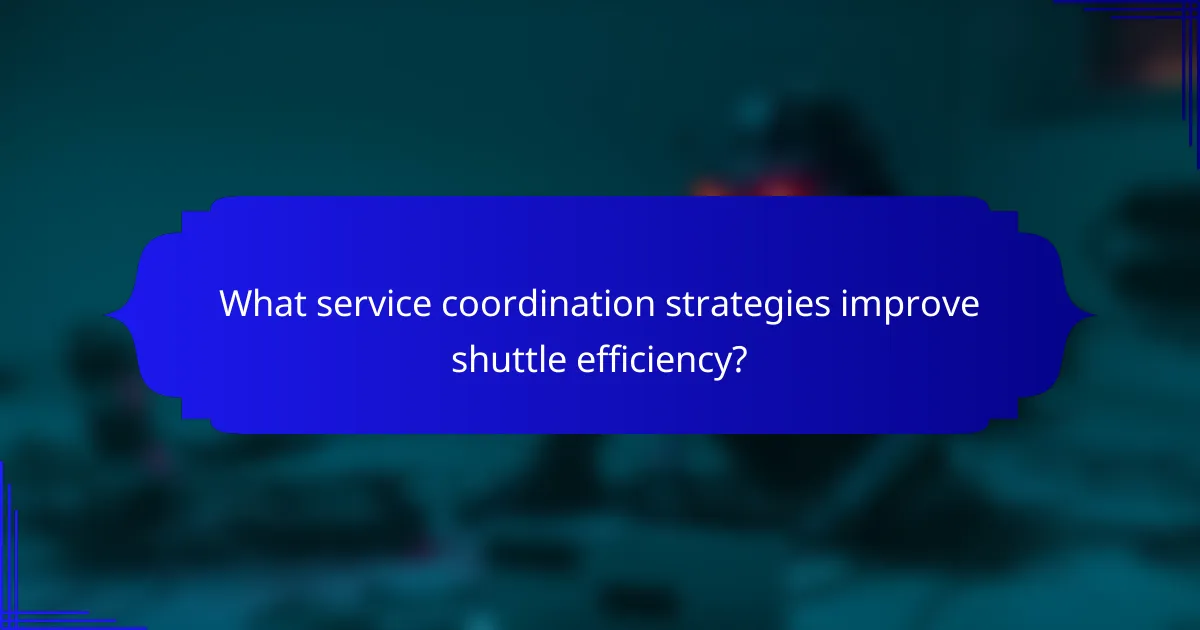
What service coordination strategies improve shuttle efficiency?
Effective service coordination strategies enhance shuttle efficiency by streamlining operations, reducing wait times, and improving passenger experience. Key approaches include implementing centralized booking systems, forming partnerships with local transport services, and investing in staff training programs.
Centralized booking systems
Centralized booking systems allow for real-time management of shuttle reservations, which can significantly reduce scheduling conflicts and optimize vehicle utilization. By using a single platform, passengers can easily book rides, track shuttle locations, and receive updates on service changes.
Consider integrating mobile apps or web platforms that facilitate user-friendly booking experiences. This can lead to higher customer satisfaction and potentially increase ridership numbers, as users appreciate the convenience of managing their travel plans in one place.
Partnerships with local transport services
Establishing partnerships with local transport services, such as buses, taxis, or rideshare companies, can enhance shuttle efficiency by providing seamless connections for passengers. These collaborations can help fill gaps in service and ensure that shuttles are well-integrated into the broader transportation network.
For example, a shuttle service could coordinate with a local bus line to synchronize schedules, allowing passengers to transfer easily between services. This not only improves overall travel times but also encourages more people to use public transport options.
Staff training programs
Investing in staff training programs is crucial for improving shuttle service efficiency. Well-trained staff can manage operations more effectively, handle passenger inquiries, and respond to issues promptly, which enhances the overall experience for riders.
Focus on training that emphasizes customer service, safety protocols, and operational procedures. Regular workshops and refreshers can keep staff updated on best practices and new technologies, ensuring that they are equipped to provide high-quality service consistently.
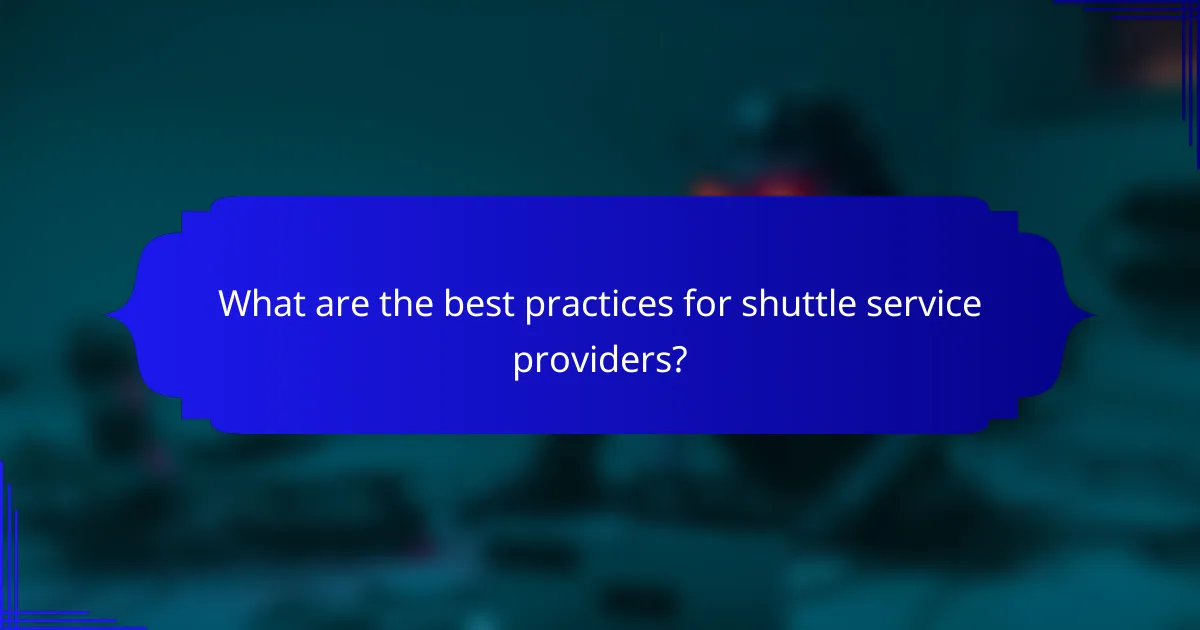
What are the best practices for shuttle service providers?
Best practices for shuttle service providers focus on ensuring reliability, safety, and customer satisfaction. Implementing regular maintenance, actively seeking customer feedback, and coordinating effectively with event organizers are key to successful operations.
Regular maintenance checks
Regular maintenance checks are essential for shuttle service providers to ensure vehicle safety and reliability. This includes routine inspections of brakes, tires, and engine performance, typically conducted every few thousand kilometers or monthly, depending on usage.
Providers should establish a maintenance schedule that aligns with industry standards and local regulations. Keeping a detailed log of maintenance activities can help identify recurring issues and improve overall fleet performance.
Customer feedback loops
Establishing customer feedback loops allows shuttle service providers to gather insights on passenger experiences and service quality. This can be achieved through post-ride surveys, suggestion boxes, or direct communication channels.
Acting on feedback is crucial; providers should analyze trends and address common concerns promptly. Regularly updating customers on improvements made based on their input fosters loyalty and enhances the overall service experience.
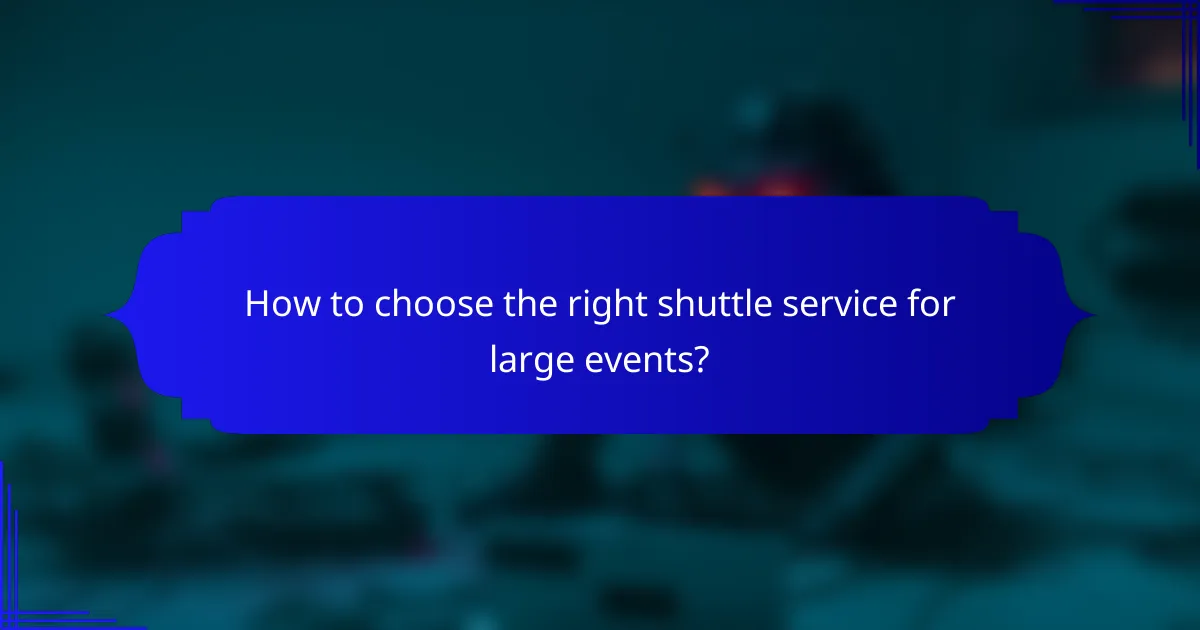
How to choose the right shuttle service for large events?
Choosing the right shuttle service for large events involves assessing the service’s capacity, customer feedback, and pricing structures. A well-suited shuttle service should effectively manage the logistics of transporting attendees while ensuring a positive experience.
Evaluating service capacity
Service capacity is crucial when selecting a shuttle service for large events. Consider the number of vehicles available, their seating capacity, and the frequency of trips to accommodate peak arrival and departure times. A good rule of thumb is to ensure that the service can handle at least 20-30% more than your expected attendance to account for fluctuations.
Additionally, inquire about the shuttle service’s ability to handle various types of events, as some may specialize in corporate gatherings while others may be better suited for festivals or concerts. Understanding their experience with similar events can provide insight into their reliability and efficiency.
Assessing customer reviews
Customer reviews offer valuable insights into the reliability and quality of a shuttle service. Look for feedback on timeliness, vehicle cleanliness, and driver professionalism. Websites like Yelp or Google Reviews can provide a broad spectrum of opinions, helping you gauge overall satisfaction.
Pay attention to recurring themes in reviews, such as consistent delays or excellent customer service. A service with a high volume of positive reviews is often a safer choice, while a pattern of negative feedback should raise red flags.
Comparing pricing structures
Pricing structures can vary significantly among shuttle services, so it’s essential to compare costs carefully. Some services may charge a flat rate, while others might have per-passenger fees or hourly rates. Be sure to clarify what is included in the price, such as fuel surcharges, tolls, and gratuities.
Request quotes from multiple providers and compare them side by side. Look for any hidden fees that could affect your budget. A transparent pricing model will help you make an informed decision while ensuring you stay within your financial limits for the event.
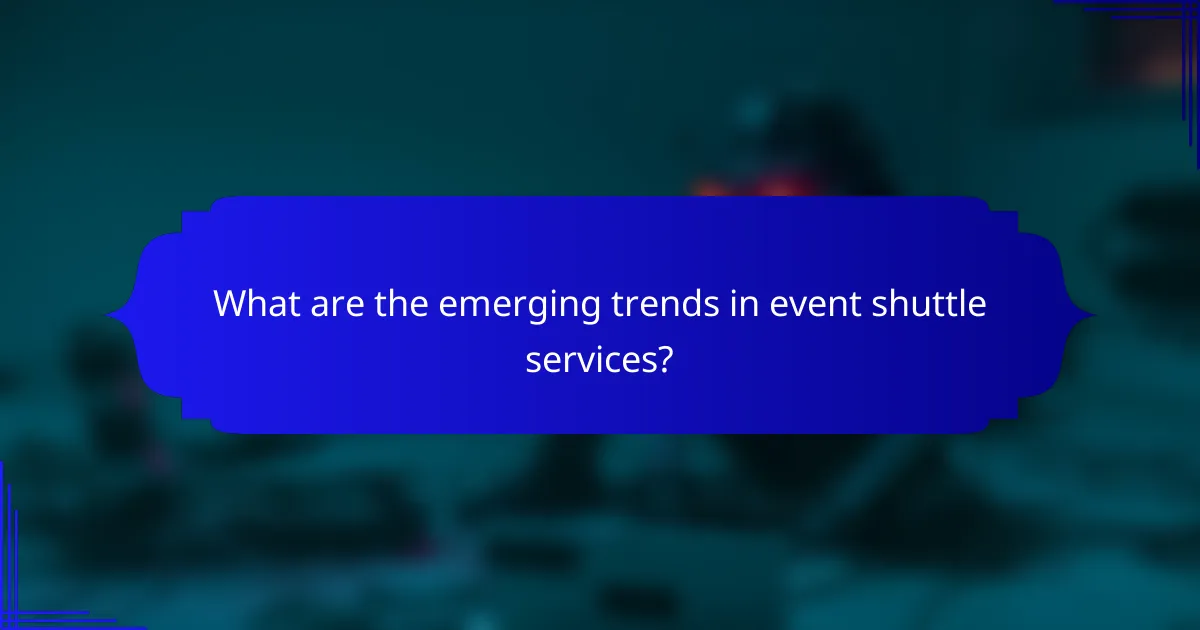
What are the emerging trends in event shuttle services?
Emerging trends in event shuttle services focus on enhancing efficiency, sustainability, and user experience. Innovations such as real-time tracking, eco-friendly vehicles, and integrated mobile apps are becoming standard to meet the growing demands of event organizers and attendees.
Logistical challenges in event shuttle services
Logistical challenges in event shuttle services often include traffic congestion, route optimization, and scheduling conflicts. Event planners must consider peak times and potential delays, which can impact the overall experience for attendees. Effective communication with shuttle drivers and real-time updates can help mitigate these issues.
Crowd management strategies
Crowd management strategies are essential for ensuring smooth operations during events. Techniques such as designated pick-up and drop-off zones, staggered shuttle schedules, and clear signage can help manage large groups effectively. Utilizing crowd control personnel can further enhance safety and organization.
Service coordination best practices
Service coordination best practices involve seamless collaboration among various stakeholders, including transportation providers, event organizers, and local authorities. Establishing clear lines of communication and setting expectations ahead of time can prevent misunderstandings. Regular briefings and debriefings can also help improve service delivery for future events.
